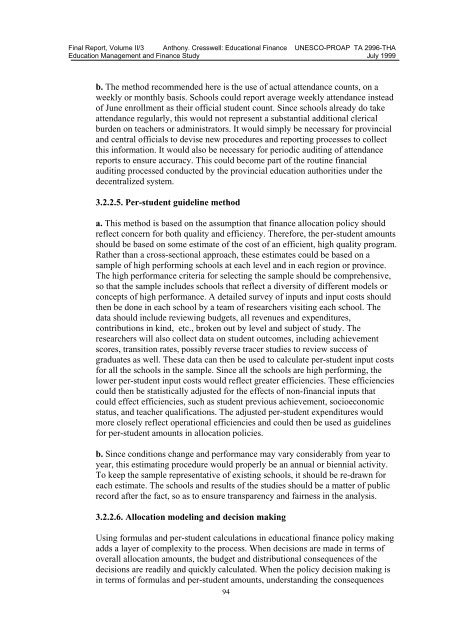Educational Finance in Thailand - UNESCO Bangkok
Educational Finance in Thailand - UNESCO Bangkok
Educational Finance in Thailand - UNESCO Bangkok
You also want an ePaper? Increase the reach of your titles
YUMPU automatically turns print PDFs into web optimized ePapers that Google loves.
F<strong>in</strong>al Report, Volume II/3 Anthony. Cresswell: <strong>Educational</strong> <strong>F<strong>in</strong>ance</strong> <strong>UNESCO</strong>-PROAP TA 2996-THA<br />
Education Management and <strong>F<strong>in</strong>ance</strong> Study July 1999<br />
b. The method recommended here is the use of actual attendance counts, on a<br />
weekly or monthly basis. Schools could report average weekly attendance <strong>in</strong>stead<br />
of June enrollment as their official student count. S<strong>in</strong>ce schools already do take<br />
attendance regularly, this would not represent a substantial additional clerical<br />
burden on teachers or adm<strong>in</strong>istrators. It would simply be necessary for prov<strong>in</strong>cial<br />
and central officials to devise new procedures and report<strong>in</strong>g processes to collect<br />
this <strong>in</strong>formation. It would also be necessary for periodic audit<strong>in</strong>g of attendance<br />
reports to ensure accuracy. This could become part of the rout<strong>in</strong>e f<strong>in</strong>ancial<br />
audit<strong>in</strong>g processed conducted by the prov<strong>in</strong>cial education authorities under the<br />
decentralized system.<br />
3.2.2.5. Per-student guidel<strong>in</strong>e method<br />
a. This method is based on the assumption that f<strong>in</strong>ance allocation policy should<br />
reflect concern for both quality and efficiency. Therefore, the per-student amounts<br />
should be based on some estimate of the cost of an efficient, high quality program.<br />
Rather than a cross-sectional approach, these estimates could be based on a<br />
sample of high perform<strong>in</strong>g schools at each level and <strong>in</strong> each region or prov<strong>in</strong>ce.<br />
The high performance criteria for select<strong>in</strong>g the sample should be comprehensive,<br />
so that the sample <strong>in</strong>cludes schools that reflect a diversity of different models or<br />
concepts of high performance. A detailed survey of <strong>in</strong>puts and <strong>in</strong>put costs should<br />
then be done <strong>in</strong> each school by a team of researchers visit<strong>in</strong>g each school. The<br />
data should <strong>in</strong>clude review<strong>in</strong>g budgets, all revenues and expenditures,<br />
contributions <strong>in</strong> k<strong>in</strong>d, etc., broken out by level and subject of study. The<br />
researchers will also collect data on student outcomes, <strong>in</strong>clud<strong>in</strong>g achievement<br />
scores, transition rates, possibly reverse tracer studies to review success of<br />
graduates as well. These data can then be used to calculate per-student <strong>in</strong>put costs<br />
for all the schools <strong>in</strong> the sample. S<strong>in</strong>ce all the schools are high perform<strong>in</strong>g, the<br />
lower per-student <strong>in</strong>put costs would reflect greater efficiencies. These efficiencies<br />
could then be statistically adjusted for the effects of non-f<strong>in</strong>ancial <strong>in</strong>puts that<br />
could effect efficiencies, such as student previous achievement, socioeconomic<br />
status, and teacher qualifications. The adjusted per-student expenditures would<br />
more closely reflect operational efficiencies and could then be used as guidel<strong>in</strong>es<br />
for per-student amounts <strong>in</strong> allocation policies.<br />
b. S<strong>in</strong>ce conditions change and performance may vary considerably from year to<br />
year, this estimat<strong>in</strong>g procedure would properly be an annual or biennial activity.<br />
To keep the sample representative of exist<strong>in</strong>g schools, it should be re-drawn for<br />
each estimate. The schools and results of the studies should be a matter of public<br />
record after the fact, so as to ensure transparency and fairness <strong>in</strong> the analysis.<br />
3.2.2.6. Allocation model<strong>in</strong>g and decision mak<strong>in</strong>g<br />
Us<strong>in</strong>g formulas and per-student calculations <strong>in</strong> educational f<strong>in</strong>ance policy mak<strong>in</strong>g<br />
adds a layer of complexity to the process. When decisions are made <strong>in</strong> terms of<br />
overall allocation amounts, the budget and distributional consequences of the<br />
decisions are readily and quickly calculated. When the policy decision mak<strong>in</strong>g is<br />
<strong>in</strong> terms of formulas and per-student amounts, understand<strong>in</strong>g the consequences<br />
94

















